Pilonidal disease
| Pilonidal disease | |
|---|---|
| Other names: Pilonidal cyst, pilonidal abscess, pilonidal sinus, sacrococcygeal fistula | |
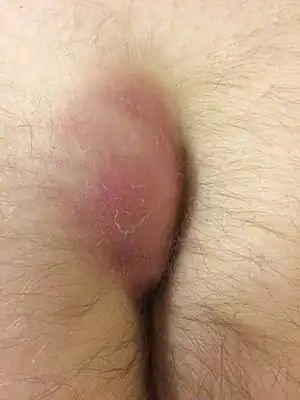 | |
| Pilonidal cysts of sudden onset in the upper gluteal cleft | |
| Specialty | General surgery, emergency medicine |
| Symptoms | Pain, swelling, redness, drainage of fluid[1] |
| Usual onset | Young adulthood[2] |
| Risk factors | Obesity, family history, prolonged sitting, greater amounts of hair, not enough exercise[2] |
| Diagnostic method | Based on symptoms and examination[2] |
| Differential diagnosis | Hidradenitis suppurativa, perianal abscess, folliculitis[2] |
| Prevention | Shaving the area[1] |
| Treatment | Incision and drainage[2] |
| Frequency | 3 per 10,000 per year[2] |
Pilonidal disease is a type of skin infection which typically occurs as a cyst between the cheeks of the buttocks and often at the upper end.[1][3] Symptoms may include pain, swelling, and redness.[1] There may also be drainage of fluid, but rarely a fever.[1][2]
Risk factors include obesity, family history, prolonged sitting, greater amounts of hair, and not enough exercise.[2] The underlying mechanism is believed to involve a mechanical process.[2] The lesions may contain hair and skin debris.[1] Diagnosis is based on symptoms and examination.[2]
If there is infection, treatment is generally by incision and drainage just off the midline.[1][2] Shaving the area may prevent recurrence.[1] More extensive surgery may be required if the disease recurs.[1] Antibiotics are usually not needed.[2] Without treatment the condition may remain long term.[1]
About 3 per 10,000 people per year are affected, and it occurs more often in males than females.[2] Young adults are most commonly affected.[2] The term "pilonidal" means "nest of hair".[1] The condition was first described in 1833.[1]
Signs and symptoms
Pilonidal cysts are itchy and often very painful, and typically occur between the ages of 15 and 35.[4] Although usually found near the coccyx, the condition can also affect the navel, armpit or genital region,[5] though these locations are much rarer.
Signs and symptoms may include:[6]
- Intermittent pain/discomfort or swelling above the anus or near the tailbone
- Opaque yellow (purulent) or bloody discharge from the tailbone area
- Unexpected moisture in the tailbone region
- Discomfort sitting on the tailbone, doing sit-ups or riding a bicycle—any activities that roll over the tailbone area
Some people with a pilonidal cyst will be asymptomatic.[7]
.jpg.webp) Pilonidal sinus
Pilonidal sinus.jpg.webp) Pilonidal sinus
Pilonidal sinus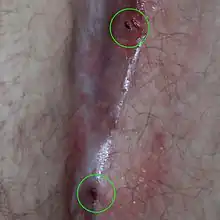 Two pilonidal cysts that have formed in the gluteal cleft
Two pilonidal cysts that have formed in the gluteal cleft
Pilonidal sinus
Pilonidal sinus (PNS): is a sinus tract, or small channel, that may originate from the source of infection and open to the surface of the skin.[8] Material from the cyst drains through the pilonidal sinus. A pilonidal cyst is usually painful, but with draining the patient might not feel pain.
Causes
One proposed cause of pilonidal cysts is ingrown hair,[9] although hairs found in pilonidal sinus tracts may originate from the head. Excessive sitting is thought to predispose people to the condition, as sitting increases pressure on the coccygeal region. Trauma is not believed to cause a pilonidal cyst; however, such an event may result in inflammation of an existing cyst; there are cases where this can occur months after a localized injury to the area. Some researchers have proposed that pilonidal cysts may be caused by a congenital pilonidal dimple.[10] Excessive sweating can also contribute to the formation of a pilonidal cyst: moisture can fill a stretched hair follicle, which helps create a low-oxygen environment that promotes the growth of anaerobic bacteria, often found in pilonidal cysts. The presence of bacteria and low oxygen levels hamper wound healing and exacerbate a forming pilonidal cyst.[11]
Diagnosis
Differential diagnosis
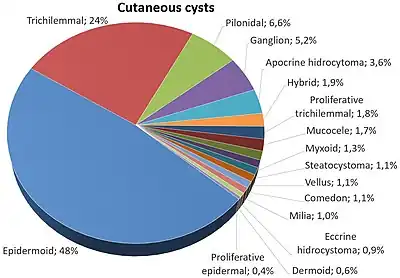
A pilonidal cyst can resemble a dermoid cyst, a kind of teratoma (germ cell tumor). In particular, a pilonidal cyst in the gluteal cleft can resemble a sacrococcygeal teratoma. Correct diagnosis is important because all teratomas require consultation with an oncologist and complete surgical excision, if possible without any spillage.
Treatment
If there is infection, treatment is generally by incision and drainage just off the midline.[1][2]
The evidence for elective treatment of pilonidal sinus disease is poor.[12] The most commonly performed surgery is for the pilonidal sinus complex to be surgically excised with the wound often left open to heal. Post-surgical wound packing may be necessary, and packing typically must be replaced daily for 4 to 8 weeks. In some cases, two years may be required for complete granulation to occur. Sometimes the cyst is resolved via surgical marsupialization.[13]
Surgeons can also excise the sinus and repair with a reconstructive flap technique, such as a "cleft lift" procedure or Z-plasty, usually done under general anesthetic. This approach is especially useful for complicated or recurring pilonidal disease, leaves little scar tissue and flattens the region between the buttocks, reducing the risk of recurrence.[11] This approach typically results in a more rapid recovery than the traditional surgery, however there are fewer surgeons trained in the cleft lift procedure and it consequently may not be as accessible to patients, depending on their location. Meta-analysis shows recurrence rates were lower in open healing than with primary closure (RR 0.60, 95% CI 0.42 to 0.87), at the expense of healing time.[14] Pilonidal cysts can recur, and do so more frequently if the surgical wound is sutured in the midline, as opposed to away from the midline, which obliterates the natal cleft and removes the focus of shearing stress. An incision lateral to the intergluteal cleft is therefore preferred, especially given the poor healing of midline incisions in this region. Minimally invasive techniques with no wound and rapid return to full activities have been reported but await double blind randomised trials.[15]
Another technique is to treat pilonidal sinus with fibrin glue. This technique is of unclear benefit as of 2017 due to insufficient research.[16] The evidence for any treatment is of low quality, and care must be taken not to over interpret any study in this field.[17]
 Excised pilonidal cyst
Excised pilonidal cyst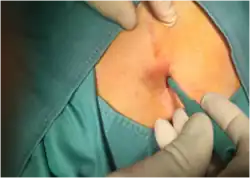 Trephine/biopsy punch minimally invasive surgery for pilonidal disease (1)
Trephine/biopsy punch minimally invasive surgery for pilonidal disease (1)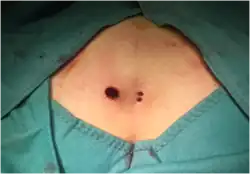 Trephine/biopsy punch minimally invasive surgery for pilonidal disease (2)
Trephine/biopsy punch minimally invasive surgery for pilonidal disease (2)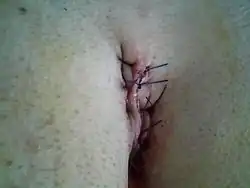 Pilonidal cyst two days after traditional closed surgery.
Pilonidal cyst two days after traditional closed surgery.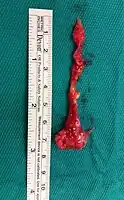 Anatomy of pilonidal disease removed after trephine or biopsy punch surgery: pilonidal fistula (top) and pilonidal cyst (bottom)
Anatomy of pilonidal disease removed after trephine or biopsy punch surgery: pilonidal fistula (top) and pilonidal cyst (bottom)
Etymology
Pilonidal means nest of hair and is derived from the Latin words for hair (pilus) and nest (nidus).[4] The condition was first described by Herbert Mayo in 1833.[18] R.M. Hodges was the first to use the phrase pilonidal cyst to describe the condition in 1880.[19][20]
The condition was widespread in the United States Army during World War II. The condition was termed "Jeep seat" or "Jeep riders' disease", because a large portion of people who were being hospitalized for it rode in Jeeps, and prolonged rides in the bumpy vehicles were believed to have caused the condition due to irritation and pressure on the coccyx.
References
- 1 2 3 4 5 6 7 8 9 10 11 12 13 Khanna A, Rombeau JL (March 2011). "Pilonidal disease". Clinics in Colon and Rectal Surgery. 24 (1): 46–53. doi:10.1055/s-0031-1272823. PMC 3140333. PMID 22379405.
- 1 2 3 4 5 6 7 8 9 10 11 12 13 14 15 Ferri, Fred F. (2017). Ferri's Clinical Advisor 2018 E-Book: 5 Books in 1. Elsevier Health Sciences. p. 995. ISBN 9780323529570. Archived from the original on 2021-08-28. Retrieved 2020-09-20.
- ↑ James WD, Berger T, Elston D (2015). Andrews' Diseases of the Skin E-Book: Clinical Dermatology. Elsevier Health Sciences. p. 675. ISBN 9780323319690. Archived from the original on 2021-08-28. Retrieved 2020-09-20.
- 1 2 "Pilonidal Cyst: Definition". Mayo Clinic. December 5, 2012. Archived from the original on December 27, 2012. Retrieved February 8, 2013.
- ↑ Rao AR, Sharma M, Thyveetil M, Karim OM (December 2006). "Penis: an unusual site for pilonidal sinus". International Urology and Nephrology. 38 (3–4): 607–8. doi:10.1007/s11255-005-4761-5. PMID 17111086. S2CID 30090441.
- ↑ Sternberg, Jeffrey. "What Is Pilonidal Disease". Archived from the original on November 11, 2014. Retrieved November 14, 2014.
- ↑ Doerr, Steven. "Pilonidal Cyst". eMedicineHealth. p. 1. Archived from the original on February 12, 2013. Retrieved February 8, 2013.
- ↑ "PNS Acronyms". thefreedictionary.com. Archived from the original on 2018-01-04. Retrieved 2018-01-03.
- ↑ "Pilonidal Cyst: Causes". Mayo Clinic. December 5, 2012. Archived from the original on October 25, 2008. Retrieved February 8, 2013.
- ↑ da Silva JH (August 2000). "Pilonidal cyst: cause and treatment". Diseases of the Colon and Rectum. 43 (8): 1146–56. doi:10.1007/bf02236564. PMID 10950015. S2CID 189796851.
- 1 2 Bascom J, Bascom T (October 2002). "Failed pilonidal surgery: new paradigm and new operation leading to cures". Archives of Surgery. 137 (10): 1146–50, discussion 1151. doi:10.1001/archsurg.137.10.1146. PMID 12361421.
- ↑ Brown SR, Lund JN (December 2019). "The evidence base for pilonidal sinus surgery is the pits". Techniques in Coloproctology. 23 (12): 1173–1175. doi:10.1007/s10151-019-02116-5. PMC 6890656. PMID 31754976.
- ↑ Patel, Patel, Patel, Patel (March 1999). "Prolonged delay in healing after surgical treatment of pilonidal sinus is avoidable". Colorectal Disease. 1 (2): 107–10. doi:10.1046/j.1463-1318.1999.00030.x. PMID 23577714. S2CID 206172705.
- ↑ Al-Khamis A, McCallum I, King PM, Bruce J (January 2010). "Healing by primary versus secondary intention after surgical treatment for pilonidal sinus". The Cochrane Database of Systematic Reviews (1): CD006213. doi:10.1002/14651858.CD006213.pub3. PMC 7055199. PMID 20091589.
- ↑ Hardy, Edward John Oliver; Herrod, Philip J; Doleman, Brett; Phillips, Hannah G; Ranat, Reesha; Lund, Jonathan N (November 2019). "Surgical interventions for the treatment of sacrococcygeal pilonidal sinus disease in children: A systematic review and meta-analysis". Journal of Pediatric Surgery. 54 (11): 2222–2233. doi:10.1016/j.jpedsurg.2019.02.058. PMID 30940347.
- ↑ Lund, Jon; Tou, Samson; Doleman, Brett; Williams, John P (13 January 2017). "Fibrin glue for pilonidal sinus disease". Cochrane Database of Systematic Reviews. 1: CD011923. doi:10.1002/14651858.CD011923.pub2. PMC 6464784. PMID 28085995.
- ↑ Brown, S. R.; Lund, J. N. (2019-12-01). "The evidence base for pilonidal sinus surgery is the pits". Techniques in Coloproctology. 23 (12): 1173–1175. doi:10.1007/s10151-019-02116-5. ISSN 1128-045X. PMC 6890656. PMID 31754976.
- ↑ Lanigan M (September 27, 2012). "Pilonidal Cyst and Sinus". Medscape. WebMD. Archived from the original on October 22, 2008. Retrieved February 8, 2013.
- ↑ Hodges RM (1880). "Pilonidal sinus". The Boston Medical and Surgical Journal. 103 (21): 485–586. doi:10.1056/NEJM188011181032101. Archived (PDF) from the original on 2021-08-28. Retrieved 2020-02-10.
- ↑ Kanerva L, Elsner P, Wahlberg JE, Maibach HI, eds. (2000). Handbook of occupational dermatology. Berlin: Springer. ISBN 3-540-64046-0.
External links
| Classification | |
|---|---|
| External resources |
- NHS Choices for pilonidal sinus treatment Archived 2011-09-10 at the Wayback Machine